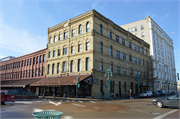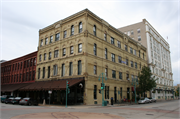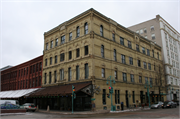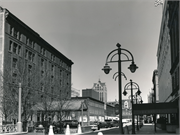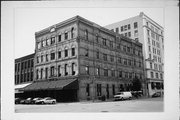Property Record
343 N BROADWAY (A.K.A. 225 E ST PAUL AVE)
Architecture and History Inventory
| Historic Name: | Merchant Mills Block |
|---|---|
| Other Name: | Third Ward Cafe |
| Contributing: | Yes |
| Reference Number: | 16136 |
| Location (Address): | 343 N BROADWAY (A.K.A. 225 E ST PAUL AVE) |
|---|---|
| County: | Milwaukee |
| City: | Milwaukee |
| Township/Village: | |
| Unincorporated Community: | |
| Town: | |
| Range: | |
| Direction: | |
| Section: | |
| Quarter Section: | |
| Quarter/Quarter Section: |
| Year Built: | 1865 |
|---|---|
| Additions: | 1875 |
| Survey Date: | 20002010 |
| Historic Use: | warehouse |
| Architectural Style: | Commercial Vernacular |
| Structural System: | |
| Wall Material: | Brick |
| Architect: | Edward Townsend Mix |
| Other Buildings On Site: | |
| Demolished?: | No |
| Demolished Date: |
| National/State Register Listing Name: | Historic Third Ward District |
|---|---|
| National Register Listing Date: | 3/8/1984 |
| State Register Listing Date: | 1/1/1989 |
| National Register Multiple Property Name: |
| Additional Information: | SEE HAER FORM. BUILT FOR JEWETT AND SHERMAN, PURVEYORS OF COFFEE AND SPICES. Original cost of building was $35,000. M IN THE PHOTO CODES IS SHORT FOR MVIS NEGATIVES. This four-story sandblasted cream brick building is designed in the Victorian Gothic style with foliate designs on the keystones, pointed arches, an arcuated cornice and projecting string courses. The original double-hung windows have been replaced in part by fixed panes. The (Jewett & Sherman Co.) Merchant Mills Block is significant as one of the oldest intact industrial buildings in the city. Its architectual detail is exceptionally fine for an industrial structure. HISTORICAL BACKGROUND AND SIGNIFICANCE: This mill construction building is one of a handful of survivors of the 1892 fire. It was built in 1875 and occupied for 45 years by Jewett & Sherman Co.'s Merchant Mills. The Jewett and Sherman Building anchors the north end of the block-long "Commission Row," the heart of the city's wholesale produce trade since the turn of the century. The block is notable for its long, rhythmic façade created by the repetition of projecting brick piers and other simple architectural elements. To most visitors, Commission Row looks quiet, but early every weekday morning it still throngs with fruit and flower merchants loading their trucks under the broad metal awnings. Established in 1867 a block away, the firm expanded from preparing and jobbing coffee and spices to manufacturing baking powder, dry and prepared mustard, flavoring extracts, essence of coffee and bluing. The firm was reputed to have one of the most extensive selections of these goods, and was described as one of the busiest institutions in Milwaukee in 1892. In 1940 the building was used as a commission house, then for offices and a restaurant. It was remodeled in 1977 for produce storage, with a restaurant on the first floor and artist's studios and offices on the second to fourth floors. What was the "commodious" and "elegant" home of one of Milwaukee's most prominent firms a century ago has lost much of its ornamentation and has suffered fire damage, but still stands as the oldest manufacturing building in the Third Ward. Resurveyed for Milwaukee Downtown Connector Arch/History Survey, SHPO#10-0983, Prepared by Heritage Research (2010). |
|---|---|
| Bibliographic References: | BUILT IN MILWAUKEE, LANDSCAPE RESEARCH, P. 80. Flower, History of Milwaukee, 1881, pp. 1208-09.f Milwaukee, 1881, pp. 1208-09. Historic Third Ward Historic Walking Tour, Historic Third Ward Association, 2009. Buildings of Wisconsin manuscript. |
| Wisconsin Architecture and History Inventory, State Historic Preservation Office, Wisconsin Historical Society, Madison, Wisconsin |

